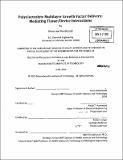| dc.contributor.advisor | Paula T. Hammond and Robert Langer. | en_US |
| dc.contributor.author | Macdonald, Mara Lee | en_US |
| dc.contributor.other | Harvard University--MIT Division of Health Sciences and Technology. | en_US |
| dc.date.accessioned | 2010-09-01T16:29:53Z | |
| dc.date.available | 2010-09-01T16:29:53Z | |
| dc.date.copyright | 2010 | en_US |
| dc.date.issued | 2010 | en_US |
| dc.identifier.uri | http://hdl.handle.net/1721.1/58091 | |
| dc.description | Thesis (Ph. D.)--Harvard-MIT Division of Health Sciences and Technology, 2010. | en_US |
| dc.description | Pages 185-186 blank. Cataloged from PDF version of thesis. | en_US |
| dc.description | Includes bibliographical references (p. 171-184). | en_US |
| dc.description.abstract | This thesis focuses on the use of ultrathin therapeutic protein delivery films to control host tissue/medical device implant interactions, thereby reducing complications that lead to implant failure. The Layer by Layer (LbL) deposition platform was used to fabricate conformal, tunable, micron scale reservoirs for the controlled release of a wide variety of proteins including enzymes, growth factors, and antibodies that were shown to be capable of directing cells in vitro to desired outcomes including proliferation, differentiation, and quiescence. Film release profiles were controlled through rational polymer design, tuning film composition, and varying film architecture. In studies with a model protein lysozyme, 100% retention of protein function was observed, underscoring gentle process conditions. In vitro experiments with Fibroblast Growth Factor-2 (FGF-2) and Bone Morphogenetic Protein -2 (BMP-2) showed that released growth factors are more active than growth factors supplemented in medium, suggesting a surface concentration mechanism and/or specific growth factor interactions with LbL film components. Anti-VEGF releasing LbL films afforded new opportunities to modify cancer therapy nanoparticles for multi therapeutic release, and provided an important switch to turn off the cellular response to growth factors. Using an orthopedic hip implant model as a test case, the first LbL film with enough growth factor load to direct in vivo host cell response was demonstrated. BMP-2 releasing LbL films were used to direct MC3T3 pre-osteoblast differentiation in vitro, and the differentiation of host mesenchymal stem cells in a rat quadriceps model in vivo to form bone tissue in a first generation model for remediating orthopedic hip implant complications. Preliminary data on second generation, multifunctional drug delivery films are promising. These studies contribute to the mechanistic design of protein LbL films and show promise for a wide variety of clinical applications, opening avenues for multifunctional drug delivery from LbL films. | en_US |
| dc.description.statementofresponsibility | by Mara Lee Macdonald. | en_US |
| dc.format.extent | 186 p. | en_US |
| dc.language.iso | eng | en_US |
| dc.publisher | Massachusetts Institute of Technology | en_US |
| dc.rights | M.I.T. theses are protected by
copyright. They may be viewed from this source for any purpose, but
reproduction or distribution in any format is prohibited without written
permission. See provided URL for inquiries about permission. | en_US |
| dc.rights.uri | http://dspace.mit.edu/handle/1721.1/7582 | en_US |
| dc.subject | Harvard University--MIT Division of Health Sciences and Technology. | en_US |
| dc.title | Polyelectrolyte multilayer growth factor delivery : mediating tissue/device interactions | en_US |
| dc.type | Thesis | en_US |
| dc.description.degree | Ph.D. | en_US |
| dc.contributor.department | Harvard University--MIT Division of Health Sciences and Technology | |
| dc.identifier.oclc | 655900188 | en_US |
